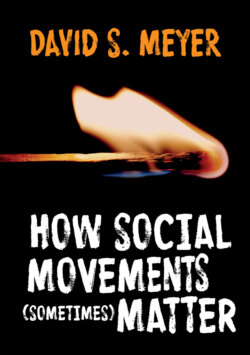Читать книгу How Social Movements (Sometimes) Matter - David S. Meyer - Страница 13
Summing Up
ОглавлениеWe can outline a schematic process to map the trajectory of a social movement cycle. We begin with the recognition of a political, social, or policy person. Such recognition could come from government, citizen action, or the confluence of events, like an accident, a war, or new information. The development of a problem may reflect a change in objective conditions, or simply the perception of those conditions. Step two entails the development of a schism among political elites. The divide may come over the recognition of the problem itself, or about the range of possible remedies that can be considered legitimate. The divide within governance leads to a third stage, greater public attention, facilitated by the relevant media of the moment. With divides and political attention, a fourth stage opens when groups concerned with citizen mobilization grow, with new groups developing and established ones taking on new activists, and generating more activity – and visibility. These groups offer criticism of current policies or realities and offer alternatives. Activist groups grow around a particular set of claims and potential resolutions. This is a particularly unstable moment, and liberal democratic governments respond in a variety of ways, often accepting some portion of activist goals or rhetoric while rejecting others. Social movements end with a sixth stage, when a new institutional accommodation is reached, and unusual mobilization no longer takes place (Meyer 1993).
Like any stage framework, this model is a heuristic that offers a map for understanding any movement, but not a very good description of any particular movement. Action is taking place in all the stages at once, and in the contemporary era, movements don’t really end so neatly, but continue on in more modest and less visible ways – although not necessarily with less impact (Meyer and Tarrow 1998).
We need to sum up some of what all this means. Most significantly, social movements are themselves the product of political dynamics, as well as contributors to those dynamics. Social movements surely play a role in creating history, but they are not completely insulated from the history that gives rise to their emergence (Amenta et al. 2010; Giugni 1998). The forces that create the impetus for social protest also create the pressure for political change. In this context, the efficacy of social movements involves maximizing the impact of the waves that they are on, but movements have limited impact on creating those waves.
To make sense of the influence of movements, that is, how movements matter, we need to develop a good understanding of the factors that give rise to them, that is, the conditions that allow movements to emerge in the first place. In this regard, the influence of social movements is a function of the ability of organizers and activists to get the most out of the waves they ride.
Here’s the surfing analogy: Surfing is an extremely difficult sport. A surfer needs to paddle out through current, ducking under or paddling over waves, and then position herself in the ocean ready to catch waves when they come by. As the waves appear in sets, the skillful surfer starts paddling purposefully when a promising wave appears, but there are generally missteps, and there are moments of competition and courtesy with other surfers seeking to ride the same wave. Often, a surfer is wiped out immediately, or unable to catch the wave. The most skillful, however, time their paddling carefully, stand at the right time, and can not only navigate survival upright, but also pose moves up and down the face of the wave. A great surfer can maximize the length of his ride, and pull off when what the wave offers is no longer interesting, paddling out once more to be in position for the next opportunity.
What’s not quite right about this metaphor is that social movements, unlike surfers, can help kick up the waves as well as ride them.
